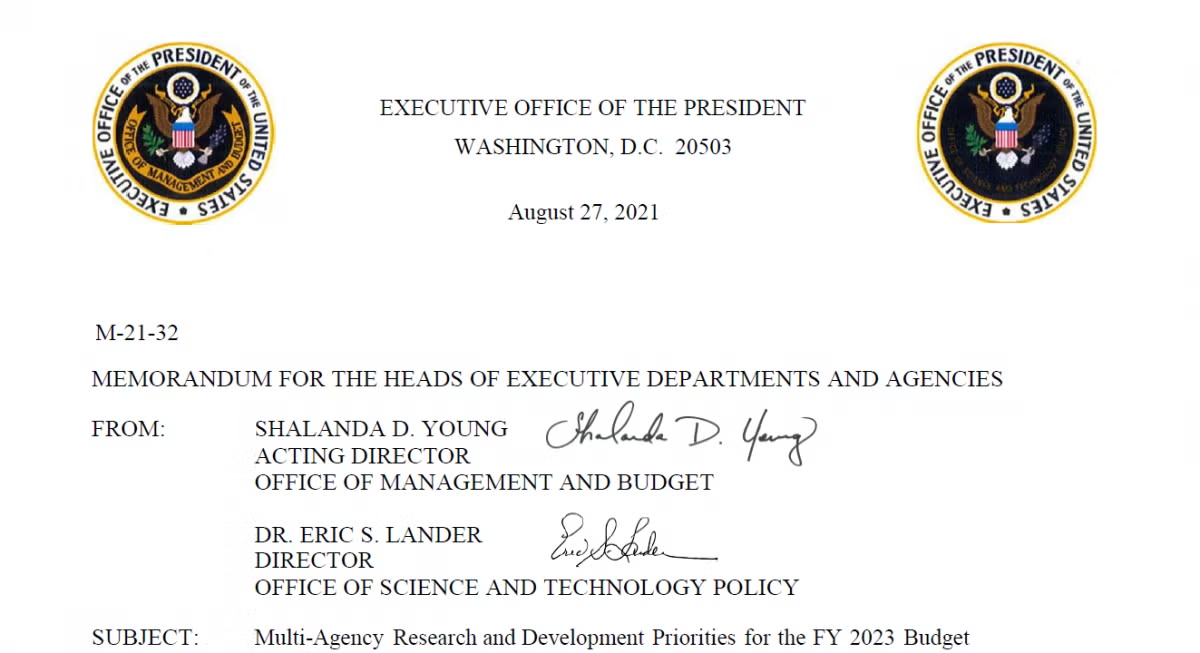White House Multi-Agency R&D Priorities for FY 2023 Budget
*Pertinent excerpts cross-posted from August 27, 2021 White House OMB-OSTP Memo*

'...This memorandum outlines the Administration's multi-agency R&D priorities for formulating fiscal year (FY) 2023 Budget submissions to the Office of Management and Budget (OMB). The priorities covered in this memo require continued investments in R&D; science, technology, engineering, and mathematics (STEM) education and engagement; STEM workforce development; technology transfer and commercialization; and research infrastructure. These priorities should be addressed within the FY 2023 Budget guidance levels provided by OMB....
....Agency budget submissions should note when they address the priorities described below. Agencies engaged in complementary activities should consult with each other during the budget planning process to coordinate resources, maximize impact, and avoid unnecessary duplication, and they should include summaries of these discussions in their OMB budget submissions....
Multi-Agency R&D Priorities
In the FY 2023 Budget, agencies should balance priorities to ensure that resources are allocated for agency-specific, mission-driven R&D, including fundamental research, while at the same time focusing resources, where appropriate, on the following multi-agency R&D activities that cannot be addressed solely by a single agency.....'
The U.S. Carbon Cycle Science Program pertinent priorities from this memo are pasted below, for your reference.
'...Tackling climate change.
The United States and the world face a profound climate crisis with a narrow moment to pursue action to avoid the most catastrophic impacts and to seize the opportunities that tackling climate change presents. This crisis is interconnected with the staggering levels of biodiversity loss occurring across the globe because climate change is exacerbating the impacts that other drivers are having on biodiversity. The President has directed a whole-of-Government approach to reduce climate pollution in every sector of the economy, increase resilience to the impacts of climate change, and protect public health, while creating good-paying jobs that provide a free and fair chance to join a union and collectively bargain.
Agencies should identify and prioritize R&D investments that advance understanding of climate change and the development of mitigation and adaptation solutions. Priorities include:
Climate science: Advancing climate science to improve understanding of Earth’s changing climate and changes that pose the greatest risk to society.This includes: facilitating public access to climate-related information that will assist Federal, State, local, and Tribal governments in climate planning and resilience activities, coupled with capacity building and training to increase access to and support the use of data, information, and climate services; research to advance understanding of the societal and economic impacts of climate change (e.g., human and ecosystem health, wildlife and fisheries); improving observational networks to create carbon inventories and baselines; improving modeling capabilities for local-scale, regional climate and related extreme weather events; and disaster attribution science, including in potential tipping points in physical, natural, and human systems.
Innovation in clean-energy technologies and infrastructure: Spurring innovation, commercialization, and deployment of clean energy and climate technologies, including those to lower the cost and decrease emissions in the power, buildings, transportation, industrial, and agricultural sectors; supporting achievement of a 50-52 percent reduction from 2005 levels in economy-wide net greenhouse gas pollution in 2030 and carbon pollution free electricity by 2035. Investments should include R&D, demonstration, and deployment to support the scale-up and transition to operations of emerging clean energy and other emissions mitigation enabling technologies, such as utility-scale energy storage and other zero-carbon grid resilience technologies; carbon capture, utilization and storage; clean hydrogen; advanced nuclear power; rare earth element separations; floating offshore wind; and sustainable biofuels/bioproducts. Agencies should support interdisciplinary research, including research in the humanities and social sciences, to ensure that our climate innovation efforts are connected to and reflective of our broad societal goals and incorporate the views of affected communities and stakeholders, including the views of historically marginalized and overburdened communities. In addition, agency budget submissions should include provisions to prioritize the procurement of promising innovative climate technologies exiting the Federal R&D pipeline to increase their marketability.
Climate adaptation and resilience: Increasing adaptation and resilience, including through integration of physical, natural, and social sciences. In addition, agencies should inform resilience efforts by prioritizing efforts to connect science and decision making through meaningful engagement with climate information users, including through the application of user-friendly climate tools and services, as well as science-based risk communication and citizen and community science programs. These investments should advance the economy and public health through reduced vulnerability to climate impacts.
Nature-based climate solutions for mitigation and adaptation: Pursuing nature-based climate solutions, including protecting and restoring terrestrial, coastal, and ocean ecosystems to provide carbon sequestration and storage and to enhance ecosystem and human community resilience.
Monitoring and measurement: Measuring and monitoring the greenhouse gas emission reduction benefits of climate investments are imperative to continue identifying and implementing effective climate solutions. Agencies should prioritize investments to measure and monitor greenhouse gas pollution reductions, including to assess the causal effectiveness of Federal programs.....'




